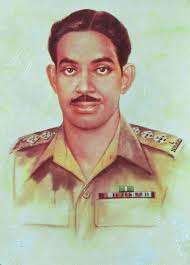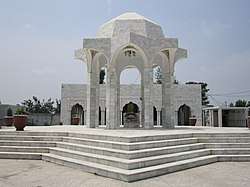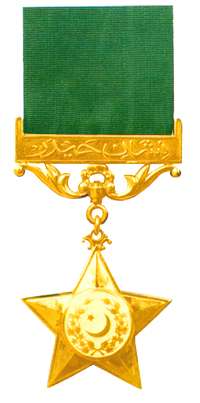Raja Muhammad Sarwar
Captain Raja Muhammad Sarwar Bhatti (Urdu: راجہ محمد سرور بھٹی; b. 10 November 1910 – 27 July 1948) NH, BS, best known as Muhammad Sarwar,[1] was a military officer in the Pakistan Army who was cited with the first Nishan-i-Haider for his gallant and actions of valor during the first war between India and Pakistan in 1947–48.[2]
Muhammad Sarwar | |
|---|---|
 Portrait of Capt. R. Muhammad Sarwar (1910–48) | |
| Birth name | Raja Muhammad Sarwar Bhatti |
| Born | 10 November 1910 Singhori village in Gujar Khan Tehsil, Rawalpindi District, Punjab in British India (Present day in Punjab in Pakistan) |
| Died | 27 July 1948 (aged 37) Uri, Jammu and Kashmir in India |
| Buried | |
| Allegiance | |
| Branch/service | |
| Years of service | 1929–48 |
| Rank | |
| Unit | |
| Battles/wars | Burma Campaign in 1944–45 Indo-Pakistani War of 1947–48 † |
| Awards | |
| Memorials | G.T. Road near the Gujar Khan Tehsil, Rawalpindi District, Punjab in Pakistan |
Biography
Raja Muhammad Sarwar Bhatti was born in a small village, Singhori, that was located in the vicinity of the Gujar Khan Tehsil, Rawalpindi District, Punjab in India on 10 November 1910, according to his tombstone.[3] He was a military brat whose father, Raja Muhammad Hayat Khan Bhatti, was an enlist in the Indian Army, retiring at rank of Havildar, a Sergeant.[3] His family hailed from a Muslim-caste of the Rajput tribe.[1]
He was educated in government-run schools in Rawalpindi District and secured his matriculation from a local school in Faisalabad in 1928.[3] After graduation, he followed his father, Sgt. Muhammad Hyatt, path and enlisted in the Indian Army in 1929 as a Sepoy (Pvt), where he was posted with the 2nd Battalion of the 10th Baloch Regiment (2/10th Baloch Regiment) of the Baloch Regiment {present 7th Battalion The Baloch Regiment (Steadfast Battalion)}.[3] From 1929 until 1939, he worked hard towards reaching the one of the highest enlisted ranks and was eventually promoted as the Naib Subedar (the Warrant officer-first class (WO-1) as present in the Pakistan Army) and posted in supply and ammunition with the Service Corps in 1939.[3]
In 1939, WO-1 Sarwar was invited to attend the Indian Military Academy in Dehradun and completed his military training before gaining commission in the 2nd Battalion of the 1st Punjab Regiment (2/1st Punjab Regiment) of the Indian Army in 1943.[3] In 1944, 2nd-Lt. Sarwar briefly served in the Burma, serving with distinction in the military operations in 1944–45 that earned him the Burma Star by the British administrations in Delhi in India.[4]
In 1944, 2nd-Lt. Sarwar was posted in an administrative position in the Punjab Regiment — he was promoted as Lieutenant in 1945–46.[3] In the Indian Army personnel accounts, Lt. Sarwar was known to be "a serious man with no nonsense and deeply religious who would practice his religion, Islam, devotedly and offered five prayers everyday, first offering the prayer before sunrise and concluding with the very last midnight prayer."[3]
In 1946–47, Lt. Sarwar was promoted as army captain and decided to attend the signal course before Capt. Sarwar was recommissioned in the Pakistan Army Corps of Signals in 1947, and directed towards attending the Military College of Signals.[3] After hearing the news of the first war between India and Pakistan over Jammu and Kashmir, Capt. Sarwar immediately wanted volunteered but refrained due to his officers wanted him to complete his schooling on the military signals, which he completed after an year.[3] In 1948, Capt. Sarwar took over the command of the 2nd Battalion of the Punjab Regiment of the Pakistan Army as its commanding officer, organized with the purpose of retaking Kashmir.[5]
A march towards the Uri region of the Indian Kashmir was commenced under Capt. Sarwar, and led an attack on the disorganized Indian Army's troops, forcing them to retreat from the Gilgit-Baltistan to Ladakh in Indian Kashmir on 26 July 1948.[4] Capt. Sarwar's company followed the retreated Indian Army's troops to the Uri region where his unit faced off the strongly fortified enemy position located in the Uri sector.[4] His company was only 50 yards away from the fortified enemy position as the Indian Army's soldiers begin their mortar shelling at his positions, and received instructions on leading the attack on the left side of the bunker where the shelling was taking place.:88[6] Moving towards the new position, his passage was blocked due to the barbed wires and decided to move to cut the wires with only taking six men alongside.:88[6] During the firefight, Capt. Sarwar used the bolt cutter to cut their barbed wires and due to the downpour of shelling, his chest perforated, taking a bullet with a machine gun fire.:89[6]
On 27 July 1948, Capt. Sarwar was killed while clearing the passage– he was 38 years old at the time of his death.:188[7]
Family background and personal life
Muhammad Sarwar's father, Raja Muhammad Hayat Khan, had served in the Indian Army and was decorated with the British war medal for his services in the World War I– Muhammad Hayat retired as a Havildar Sergeant and passed away on 23 November 1932.[4] Muhammad Sarwar had three brothers and one sister.[8] Raja Muhammad Sarwar married in arrange in 1936 and had a son and a daughter from that marriage.[8]
Nishan-e-Haider


The body of Capt. Sarwar is buried at the Hill of Tilpatra which is near the Uri in Indian Kashmir where he was buried on 27 July 1948.[3] It was on 23 March 1956 when the Government of Pakistan recognized his services as the Parliament of Pakistan authorized to posthumously award the Nishan-E-Haider (Eng. lit. Emblem of the Lion) for his meritorious services, which was awarded to him by the President of Pakistan.[2][9][8] The Presidential Nishan-e-Haider citation on his grave is written in Urdu; and its reads with translation as:
- Citation
- Battle of Tilpatra in Uri: When Quaid-e-Azam Muhammad Ali Jinnah declared Jihad in Kashmir and ordered Pakistan Army to participate in it. Captain Sarwar were participating in a course in GHQ's School of Signals. His unit 2 Punjab Regiment entered Kashmir to face the enemy. As soon as the course ended he persisted to take permission to participate in Jihad of Kashmir, with his unit. Seeing his determination the commanding officer gave him permission. He was appointed as the signals officer. He offered himself to fight the enemy at Tilpatra hill. On 27 July 1948, he took his men with him and challenged the enemy. The enemy opened fire with machine guns, artillery and mortars. He kept on advancing bravely. His machine gunner got martyred. He took hold of his gun and sent 40 of enemy's soldiers to hell. When a second gunner arrived he handed over the machine gun to him. He, along with some soldiers, advanced from another side and destroyed a machine gun of the enemy. He got injured during it, but kept on advancing. There was barbed wire, which he cut himself and let the soldiers pass through it and led a final assault on the enemy. During this time, a burst from the automatic machine gun of the enemy pierced his noble chest. He fell down but encouraged his soldiers to fell upon the enemy while reciting the Kalima Tayyiba—therefore his tremendous courage led him to be posthumously presented with the Nishan-e-Haider.[10]
In 1967, the federal government later established the marble tomb in his memory to offer remembrance of his career highlights in the military and martyrdom to the civil society with additional funding was later secured by Imtiaz Warraich, the MP on the platform of the Pakistan Muslim League (N) to expand the facility in his memory in 1990— the marble tomb is located near his locality.[11][12]
In memory
In 1968, a paintings exhibition was inaugurated in Lahore, Pakistan depicting Pakistani war heroes including the first sketched portrait of Capt. Muhammad Sarwar.[13]
In 1991, he was subjected a biographical war telefilm, "Captain Muhammad Sarwar Shaheed" produced and directed by the Qasim Jilali of the PTV.[14] In addition, the federal government established the community college, the Sarwar Shaheed College, in his honor near his birthplace in the Gujar Khan.[15]
Galleries
.jpg) The inscription on the life of Capt. Muhammad Sarwar at his tomb in GT Road near Lahore.
The inscription on the life of Capt. Muhammad Sarwar at his tomb in GT Road near Lahore. The monument at Sanghori (native village of Captain Raja Muhammad Sarwar Bhatti Shaheed Nishan e Haider) astride GT Road near Mandra.
The monument at Sanghori (native village of Captain Raja Muhammad Sarwar Bhatti Shaheed Nishan e Haider) astride GT Road near Mandra..jpg) The memorial of Captain Raja Muhammad Sarwar Bhatti Shaheed (Nishah e Haider) at his tomb in GT Road near Mandra.
The memorial of Captain Raja Muhammad Sarwar Bhatti Shaheed (Nishah e Haider) at his tomb in GT Road near Mandra.
See also
- Gujar Khan
- Sawar Muhammad Hussain Shaheed
- Sarwar Shaheed College
References
- Maira S (31 May 2011). "Profile of Captain Raja Muhammad Sarwar". Pakistan 360 degrees website. Retrieved 4 November 2018.
- Captain Sarwar Shaheed, Pakistan's first ever Nishan-e-Haider award recipient remembered Pakistan Today (newspaper), Published 27 July 2016, Retrieved 4 November 2018
- "Tombstone of Muhammad Sarwar". Retrieved 7 March 2019.
- Foundation, Shaheed (27 July 2018). "Shahadat Anniversary Captain Raja Muhammad Sarwar Shaheed,Nishan-e-HAIDAR[AS]... - SFP News". www.shaheedfoundation.org. Shaheed Foundation. Retrieved 8 March 2019.
- "CAPTAIN MUHAMMAD SARWAR (SHAHEED)". www.pakarmymuseum.com. pakarmymuseum. Retrieved 7 March 2019.
- Mirza, Yaqub (1947). The golden jubilee celebrations of the Islamic Republic of Pakistan (snippet view). Karachi, Sin. Pakistan: National Book Foundation. p. 115. ISBN 9789693701784. Retrieved 9 March 2019.
- Singh, Brig Jasbir (2010). Combat Diary: An illustrated history of operations conducted by 4th Battalion, The Kumaon Regiment 1788 to 1974. Lancer Publishers. p. 291. ISBN 9781935501183. Retrieved 9 March 2019.
- Captain Sarwar Shaheed remembered The News International (newspaper), Published 11 December 2017, Retrieved 4 November 2018
- Profile of Raja Muhammad Sarwar on shaheedfoundation.org website Retrieved 4 November 2018
- Amir, Tariq (12 January 2017). "Pakistan Geotagging: Monument of Captain Raja Muhammad Sarwar Shaheed: Nishan e Haider". Pakistan Geotagging. Retrieved 9 March 2019.
- "Capt Sarwar Shaheed, Pakistan's first ever Nishan-e-Haider recipient remembered". The Nation. The Nation. The Nation. 27 July 2016. Retrieved 9 March 2019.
- "Captain Sarwar Shaheed In Urdu". www.urdubiography.com. Retrieved 9 March 2019.
- From the past pages of Dawn (newspaper): Fifty years ago: War paintings show Dawn (newspaper), Published 24 April 2018, Retrieved 4 November 2018
- "Drama Serial Nishan-e-Haider "Major Tufail Mohammad Shaheed" Pakistan Army (Complete)". 8 September 2012. Retrieved 7 March 2019.
- "Sarwar Shaheed College - College & University | Facebook". www.facebook.com. Retrieved 9 March 2019.
External links
- ISPR, Staff Writer. "Captain Muhammad Sarwar". www.ispr.gov.pk. ISPR. Retrieved 8 March 2019.
- ISPR, PTV (4 February 2017). "Telefilm: Captain Raja Muhammad Sarwar Shaheed". www.youtube.com/. ISPR. Retrieved 9 March 2019.